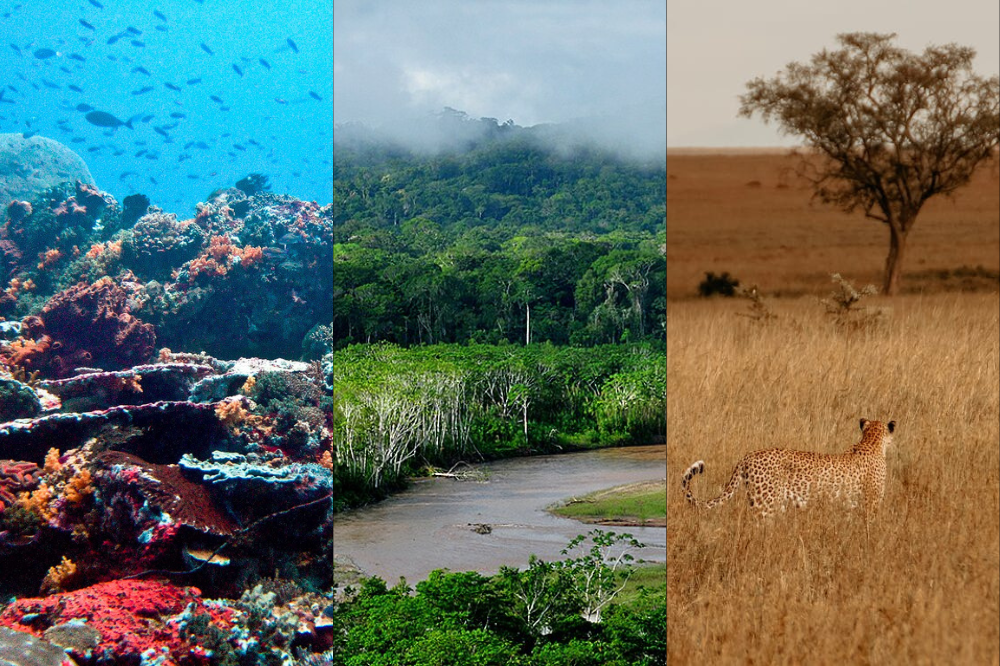One rule helps explain how life on Earth is organized—from ocean depths to open savannahs

1. Coral reef in Nusa Lembongan (Bali, Indonesia). Photo: Ilse Reijs and Jan-Noud Hutten. 2. Madidi National Park (Bolivia). Photo: Dirk Embert. 3 Cheetah on the savannah in Tanzania. Photo: Eva Purrer
An international scientific team from Sweden, Spain and United Kingdom has identified a simple rule that appears to explain how species are distributed on Earth at a large scale —regardless of whether they inhabit coral reefs, tropical rainforests, or the African plains. The study, published in the journal Nature Ecology & Evolution, shows that, across large geographic regions such as continents, despite differences in life forms and environmental conditions, global biodiversity follows a common pattern: most species are concentrated in a central "core," and biodiversity gradually decreases toward the periphery.
The study has been led by the Umeå Unviersity (Sweden) with the collaboration of the Doñana Biological Station – CSIC, the Global Change Research Institute from the Universidad Rey Juan Carlos, the Pablo de Olavide University and the University of Seville, among others. To conduct this research, studied bioregions across the world, examining species from very different life forms: amphibians, birds, dragonflies, mammals, marine rays, reptiles, and trees.
A universal pattern on a diverse planet
At first glance, Earth seems like a collection of wildly different worlds: different groups of species inhabit regions of the planet that are isolated by natural barriers such as oceans, mountains, or deserts. These barriers limit the movement of species, turning each large biogeographical region, or bioregions, into a natural experiment where distinct groups of species have evolved under different conditions, timescales, and histories. Given the vast differences in life strategies—some species fly, others crawl, swim, or remain rooted—and the contrasting environmental and historical backgrounds of each bioregion, the researchers expected that species distribution would vary widely across bioregions. Surprisingly, they found the same pattern everywhere.
“In every bioregion, there is always a core area where most species live,” explains Rubén Bernardo-Madrid, lead author and researcher at Umeå University (Sweden). “From that core, species expand into surrounding areas, but only a subset manages to persist. It seems these cores provide optimal conditions for species survival and diversification, acting as a source from which biodiversity radiates outward.”
This pattern highlights the disproportionate ecological role these small areas play in sustaining the biodiversity of entire bioregions. As emphasized José Luis Tella, from the Estación Biológica de Doñana-CSIC (Spain), “safeguarding these core zones is therefore essential, as they represent critical priorities for conservation strategies.”
The driving force behind this mechanism
But what drives this pattern? The fact that it holds across regions with very different histories points to a general process known as environmental filtering. “It doesn’t matter whether the limiting factor is heat, cold, drought, or salinity,” says co-author Manuela González-Suárez (University of Reading, UK). “The result is always the same: only species able to tolerate local conditions establish and persist, creating a predictable distribution of life on Earth.”
Environmental filtering has long been considered a key theoretical principle in ecology for explaining species distribution on Earth. Until now, however, global empirical evidence has been scarce. This study provides broad confirmation across multiple branches of life and at a planetary scale.
A step forward in understanding biodiversity
The existence of a universal organizing mechanism has profound implications for our understanding of life on Earth. As Joaquín Calatayud, co-author from the Rey Juan Carlos University (Spain), points out: “this pattern suggests that life on Earth may be, to some extent, predictable”. Such predictable patterns can help scientists trace how life has diversified through time and offer valuable insights into how ecosystems might react to global environmental changes.
This step forward in understanding life on Earth is only possible through sustained support for basic science—like the discovery of new species and their distributions—and by fostering collaboration across disciplines. As Martin Rosvall from Umeå University notes, “Sustained investment in basic science and global collaboration lets us test long-standing ideas and reveal how biodiversity has been shaped.”
Reference
Bernardo-Madrid R, González-Suárez M, Rueda M, Revilla E, Rosvall M, Carrete M, et al. A general rule on the organization of biodiversity on Earth’s biogeographical regions. Nature Ecology & Evolution. 2025. DOI: https://doi.org/10.1038/s41559-025-02724-5